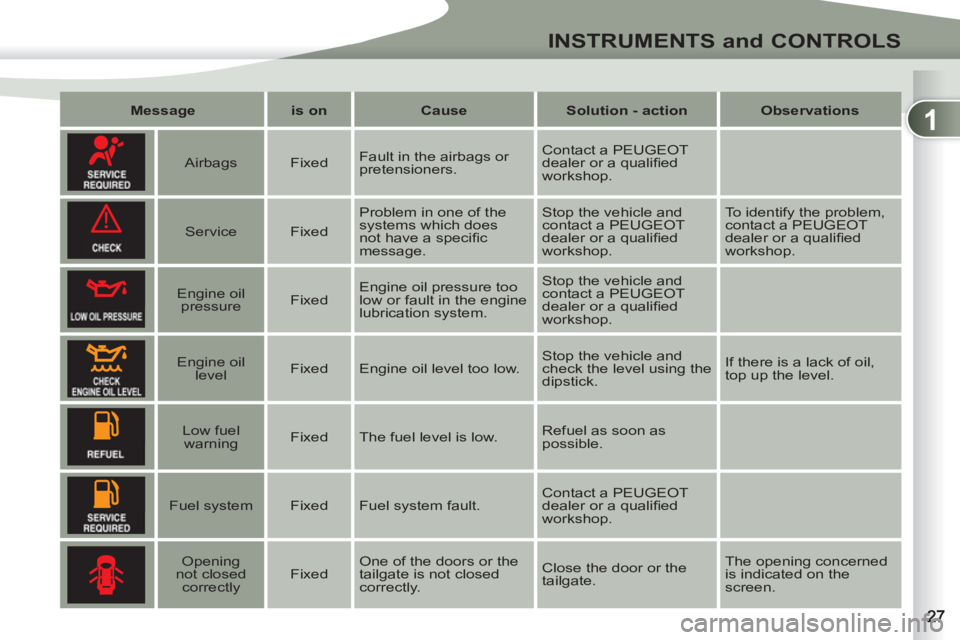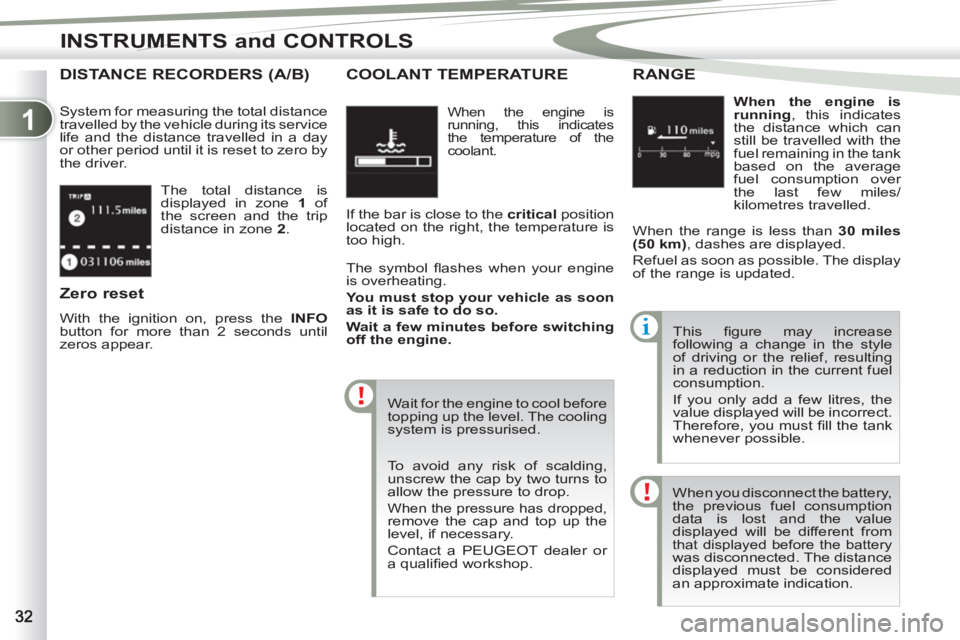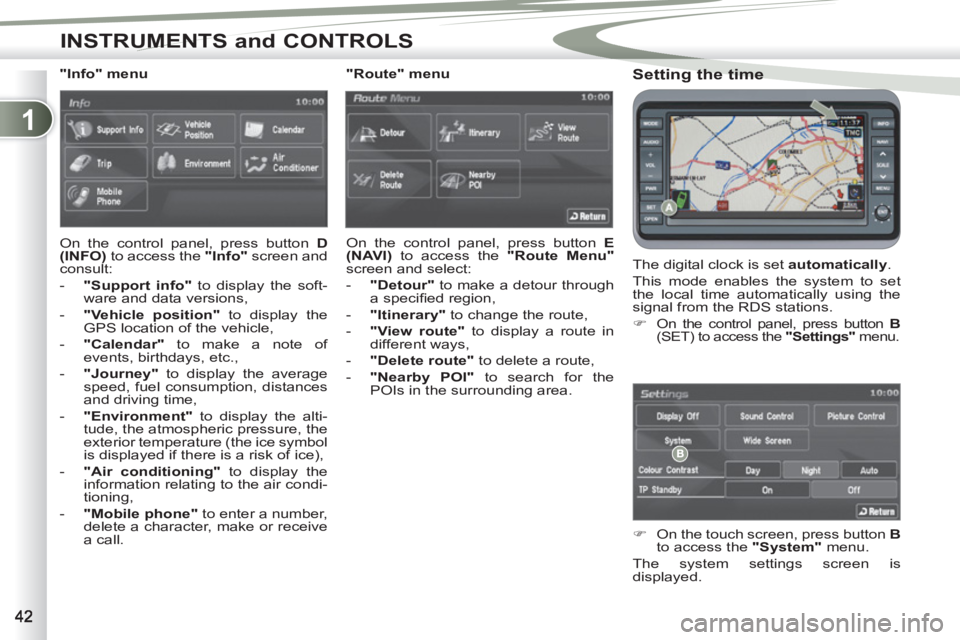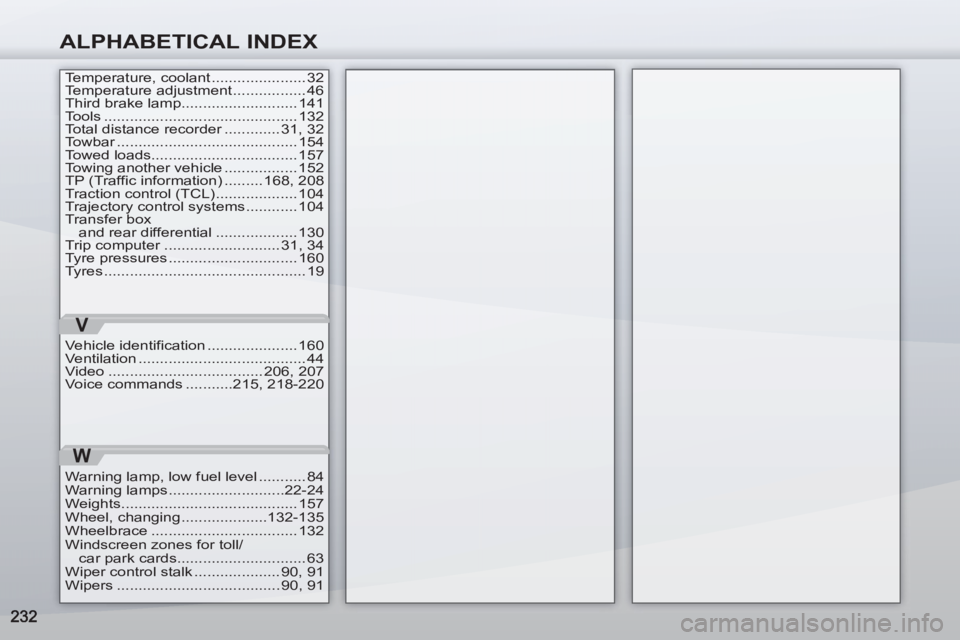2011 PEUGEOT 4007 fuel pressure
[x] Cancel search: fuel pressurePage 22 of 236

20
Limit the causes of excess
consumption
Spread loads throughout the vehicle;
place the heaviest items in the bottom
of the boot, as close as possible to the
rear seats.
Limit the loads carried in the vehicle
and reduce wind resistance (roof bars,
roof rack, bicycle carrier, trailer...). Use
a roof box in preference.
Remove roof bars and roof racks after
use.
At the end of winter, remove snow
tyres and refi t your summer tyres.
Observe the recommendations
on maintenance
Check the tyre pressures regularly,
when cold, referring to the label in the
door aperture, driver's side.
Carry out this check in particular:
- before a long journey,
- at each change of season,
- after a long period out of use.
Don't forget the spare wheel and the
tyres on any trailer or caravan.
Have your vehicle serviced regular-
ly (engine oil, oil fi lter, air fi lter...) and
observe the schedule of operations
recommended by the manufacturer.
When refuelling, do not continue after
the 3 rd cut-off of the nozzle to avoid
any overfl ow.
At the wheel of your new vehicle,
it is only after the fi rst 1 800 miles
(3 000 kilometres) that you will see
the fuel consumption settle down to a
consistent average.
Page 29 of 236

1
!
INSTRUMENTS and CONTROLS
Message
is on
Cause
Solution - action
Observations
Airbags
Fixed Fault in the airbags or
pretensioners. Contact a PEUGEOT
dealer or a qualifi ed
workshop.
Service
Fixed Problem in one of the
systems which does
not have a specifi c
message. Stop the vehicle and
contact a PEUGEOT
dealer or a qualifi ed
workshop. To identify the problem,
contact a PEUGEOT
dealer or a qualifi ed
workshop.
Engine oil
pressure
Fixed Engine oil pressure too
low or fault in the engine
lubrication system. Stop the vehicle and
contact a PEUGEOT
dealer or a qualifi ed
workshop.
Engine oil
level
Fixed Engine oil level too low. Stop the vehicle and
check the level using the
dipstick. If there is a lack of oil,
top up the level.
Low fuel
warning
Fixed The fuel level is low. Refuel as soon as
possible.
Fuel system
Fixed Fuel system fault. Contact a PEUGEOT
dealer or a qualifi ed
workshop.
Opening
not closed
correctly
Fixed One of the doors or the
tailgate is not closed
correctly. Close the door or the
tailgate. The opening concerned
is indicated on the
screen.
Page 34 of 236

1
INSTRUMENTS and CONTROLS
The total distance is
displayed in zone 1
of
the screen and the trip
distance in zone 2
.
DISTANCE RECORDERS (A/B)
System for measuring the total distance
travelled by the vehicle during its service
life and the distance travelled in a day
or other period until it is reset to zero by
the driver.
Zero reset
With the ignition on, press the INFO
button for more than 2 seconds until
zeros appear.
When the engine is
running, this indicates
the temperature of the
coolant.
COOLANT TEMPERATURE
If the bar is close to the critical
position
located on the right, the temperature is
too high.
The symbol fl ashes when your engine
is overheating.
You must stop your vehicle as soon
as it is safe to do so.
Wait a few minutes before switching
off the engine.
Wait for the engine to cool before
topping up the level. The cooling
system is pressurised.
When the engine is
running
, this indicates
the distance which can
still be travelled with the
fuel remaining in the tank
based on the average
fuel consumption over
the last few miles/
kilometres travelled.
RANGEGE
When the range is less than 30 miles
(50 km)
, dashes are displayed.
Refuel as soon as possible. The display
of the range is updated.
To avoid any risk of scalding,
unscrew the cap by two turns to
allow the pressure to drop.
When the pressure has dropped, remove the cap and top up the
level, if necessary.
Contact a PEUGEOT dealer or
a qualifi ed workshop. This fi gure may increase
following a change in the style
of driving or the relief, resulting
in a reduction in the current fuel
consumption.
If you only add a few litres, the
value displayed will be incorrect.
Therefore, you must fi ll the tank
whenever possible.
When you disconnect the battery,
the previous fuel consumption
data is lost and the value
displayed will be different from
that displayed before the battery was disconnected. The distance
displayed must be considered
an approximate indication.
Page 44 of 236

1
INSTRUMENTS and CONTROLS
Setting the time
The digital clock is set automatically
.
This mode enables the system to set
the local time automatically using the
signal from the RDS stations.
�)
On the control panel, press button B
(SET) to access the "Settings"
menu.
�)
On the touch screen, press button B
to access the "System"
menu.
The system settings screen is
displayed.
"Info" menu
On the control panel, press button D
(INFO)
to access the "Info"
screen and
consult:
- "Support info"
to display the soft-
ware and data versions,
- "Vehicle position"
to display the
GPS location of the vehicle,
- "Calendar"
to make a note of
events, birthdays, etc.,
- "Journey"
to display the average
speed, fuel consumption, distances
and driving time,
- "Environment"
to display the alti-
tude, the atmospheric pressure, the
exterior temperature (the ice symbol
is displayed if there is a risk of ice),
- "Air conditioning"
to display the
information relating to the air condi-
tioning,
- "Mobile phone"
to enter a number,
delete a character, make or receive
a call.
"Route" menu
On the control panel, press button E
(NAVI)
to access the "Route Menu"
screen and select:
- "Detour"
to make a detour through
a specifi ed region,
- "Itinerary"
to change the route,
- "View route"
to display a route in
different ways,
- "Delete route"
to delete a route,
-
"Nearby POI"
to search for the
POIs in the surrounding area.
Page 162 of 236

10
TECHNICAL DATA
A.
Manufacturer’s plate.
The Vehicle Identifi cation Number
(VIN) is indicated on a plate on the
centre pillar, on the driver’s side.
B.
Serial number under the bonnet.
The VIN is engraved on the body-
work near the windscreen.
C.
Front number plate.
D.
Tyres/paint label.
This label is affi xed to the passen-
ger’s door centre pillar. It indicates the following information:
-
tyres pressures, laden and unladen,
- wheel rim and tyre sizes,
- tyre pressure for the spare
wheel,
- paint colour code.
E.
Serial number behind the wind-
screen.
The VIN is engraved on the dash-
board, behind the windscreen. The tyre pressures must be
checked when cold at least once
a month.
IDENTIFICATION MARKINGSS
Low tyre pressures increase fuel
consumption.
Page 224 of 236

VISUAL SEARCH
EXTERIOR FRONT
Sunroof ........................................ 82-83
Windscreen wipers ...................... 90-91
Rain sensor .......................................90
Opening the bonnet .........................126
Engine ..................................... 127-128
Towing .............................................152
Brakes ..................................... 112, 131
ABS .................................................103
Tyres, pressures ..............................160
Brake pads ......................................131
Alloy wheels ....................................132 Remote control key, starting,
battery....................................... 73-76
Central locking ...................................79
Door mirrors ......................................61
Opening/closing the doors ........... 79-80
Filler cap, fi lling the fuel tank .............84
Fuel gauge ........................................84
Lighting, direction indicators,
foglamps, headlamps ............... 86-89
Changing bulbs ....................... 137-140
Page 234 of 236

ALPHABETICAL INDEX
Temperature, coolant ...................... 32
Temperature adjustment ................. 46
Third brake lamp........................... 141
Tools ............................................. 132
Total distance recorder ............. 31, 32
Towbar .......................................... 154
Towed loads.................................. 157
Towing another vehicle ................. 152
TP (Traffic information) ......... 168, 208
Traction control (TCL) ................... 104
Trajectory control systems ............ 104
Transfer box
and rear differential ................... 130
Trip computer ........................... 31, 34
Tyre pressures .............................. 160
Tyres ............................................... 19
V
Vehicle identification ..................... 160
Ventilation ....................................... 44
Video .................................... 206, 207
Voice commands ...........215, 218-220
W
Warning lamp, low fuel level ........... 84
Warning lamps ...........................22-24
Weights ......................................... 157
Wheel, changing ....................132-135
Wheelbrace .................................. 132
Windscreen zones for toll/
car park cards .............................. 63
Wiper control stalk .................... 90, 91
Wipers ...................................... 90, 91